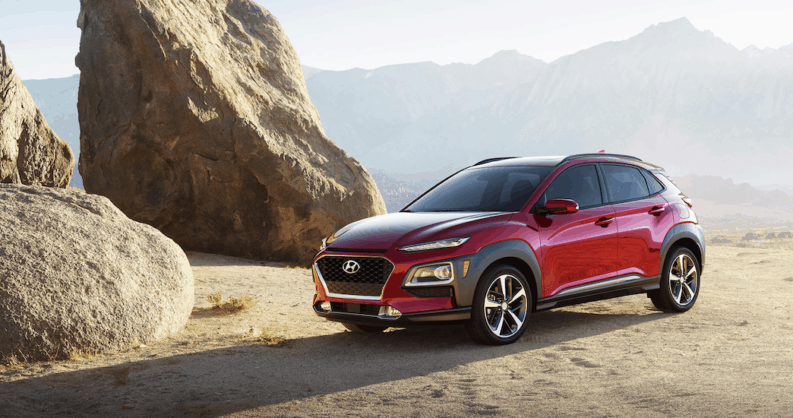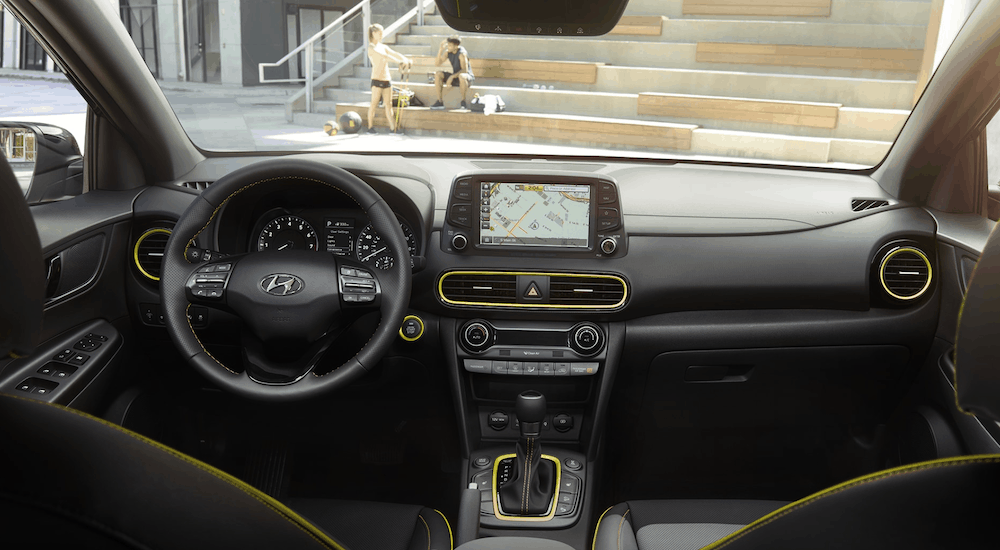For the 2018 model year, Hyundai introduced a five-door subcompact crossover SUV in the same optimistic manner in which any new model offering is served up, hopeful for both acceptance (if not outright praise).
Boasting a modern aesthetic and a confident array of capable powertrains, Hyundai knew that had a winner from day one with the Kona. And fueled by a successful introduction in South Korea, the stateside (and worldwide) launch of the all-electric Kona was met with just as much enthusiasm. In fact, both the electric and traditional versions of the Kona would share the distinction of being named 2019 North American Utility Vehicle of the Year.
But enough of the vaguely-poetic, and broad stroke descriptives. While the Kona might have neither the lengthiest or most distinguished history, it has captured an impressive amount of attention thanks to everything it brings to the party. And with that in mind, let’s get down to the fine details and see why so many people have been talking about the Hyundai Kona.
Introducing the 2018 Hyundai Kona
First things first, the inaugural Kona was nice to look at. Sporty, modern and reflective of very intentional design choices, its gaping maw, and elongated headlamp design spread outward – pulling your eye around its contoured body in an appreciation of its crossover-inspired aesthetic.
Empowered by its (two) turbocharged engine configurations, the Kona was immediately praised for its energetic performance (up to 175 hp) and agile handling. It also enjoyed respectable fuel economy ratings up to 33 mpg highway (28 city).
And of course, there was the immediate appeal of the price tag – starting as low as $19,240 MSRP. This gave it an immediate advantage over the likes of the Subaru Crosstrek, with the performance, handling and overall freshness making the Kona an easy favorite. And while there would be no shortage of praise for the Kona in its first year, one could believe that the best was yet to come.
Introducing the 2019 Hyundai Kona Electric
As of 2019, there are few automakers who haven’t thrown their hat in the proverbial ring of EV offerings (if not tried to dominate it completely). And while thoughts of electric transportation are more likely to summon thoughts of Toyota, Tesla, Rivian and even GM one can no longer turn a blind eye to the Hyundai Motor Group, and the Hyundai, Genesis and Kia brands that fall under its all-inclusive umbrella. While HMG is far from the leader in sales, they hold the distinction of introducing more plug-in models than any other automaker. In 2019, Hyundai alone offers the Ioniq (Hybrid, Plug-in Hybrid, or Electric) the Sonata (Hybrid or Plug-in Hybrid) and the Nexo (Fuel Cell).
So, it goes without saying that the immediate fanfare enjoyed by the original Kona made it a perfect candidate for electrification. A more modest footprint made it an ideal choice, for both urban commuters and the green-minded. Swapping out the traditional 1.6-liter four-cylinder for a 64.0 kWh battery with electric motor might add a few (hundred) pounds to the curb weight (seven-hundred to be precise) but it does nothing to infringe upon the core characteristics of the Kona.
With an estimated all-electric range of 258 miles (on a full charge) the Kona electric is served up in three trim levels, the (base) SEL, Limited and Ultimate — all of which build upon the characteristics that had made the Kona so impactful from day one.
And yet, some of the superficial elements have been changed. The front fascia, for example, receives a justifiable update with a more closed-off facelift. Why? Because the electric Kona doesn’t carry the same cooling burdens as its traditional combustion engine stablemate. Thus, it gains a more streamlined, reserved aesthetic that lends it a sense of leanness – while retaining the familiar crossover design that made it feel so non-threatening and welcoming.
And with 201 horsepower and 291 lb-ft of torque, the zero-emission electric powertrain of the Kona proves to be both confident and capable. It really serves as a reminder that acceptance of a more sustainable mode of transportation doesn’t mean a sacrifice to performance. An outdated concern for sure, but one that’s really only coming to light now that electrification strategies are underway for everything from rugged F-150’s to performance-driven Challengers. All in all, the Kona exists as a kick in the pants, showing us how far we’ve come from those early days of the Prius—when hybrids were synonymous with pretentiousness—or electrics which (at least initially) felt somewhat inaccessible in terms of pricing.
Ease inside the Kona, and you’ll find a cabin experience that is built for both form and function, comfortable for driver and passengers alike, which intuitive in its control placement. Shift-by-Wire technology allows for the convenience of push-button shifting, and a raised 7-inch display provides all the information required by a driver, for real-time visibility of battery charge and energy flow.
But one of the most eye-catching in-cabin notes comes from the floating center console, which creates open storage space below the center stack and armrest. Made possible by the absence of mechanical shift lever or pull-up parking brake, it’s a kitsch feature (if we’re being completely honest), but just enough to remind you that the Kona remains something unique in its own right – while retaining a sense of almost perfect timeliness.
Consider how well-equipped the (base) SEL is, boasting all the features listed above, in addition to the array of driver-assist and safety technologies. Smart cruise control, forward collision-avoidance assist, blind-spot collision warning, lane keeping assist, and rear cross-traffic collision avoidance assist are just a few “timely” features worth noting. Even the heated seating, right off the bat, is a nice touch. Moving up the trim levels, we gain the convenience of wireless device charging in the Limited trim, and infotainment upgrades in the Ultimate trim.
And in terms of pricing, the plug-in Kona kicks things off at a starting price point of around $36,450—reduced by approximated $7,500 courtesy of the electric vehicle tax credit. In turn, it may not be quite as accessibly priced as its traditional powertrain sibling, but it’s certainly comparable with other in-class competitors that might make their way onto your shortlist.
All in all, there are plenty of reasons to consider the Kona Electric.
Is the Hyundai Kona Right For You?
Whether we’re talking about the original or the electric, the Kona is a great example of a vehicle that I might have never considered if it weren’t for the opportunity to dig a bit deeper into it. And while it might never be the top of my list (based solely on my general dislike of crossover styling), it’s easy to see how the compelling Kona might win someone over—especially if it’s more their style in terms of vehicle selection.
Are you into crossovers? Are you considering the move to a plug-in electric vehicle? If so, it might be worth checking out the Kona. Everywhere you look, it seems to be all the rage.





